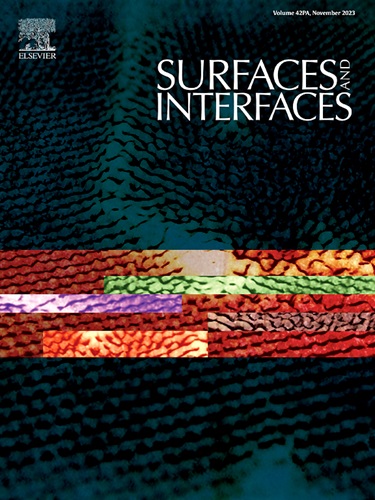Mechanistic and theoretical investigation of acetaminophen adsorption on titanium-coated biochar: Statistical physics models and DFT insights
IF 5.7
2区 材料科学
Q2 CHEMISTRY, PHYSICAL
引用次数: 0
Abstract
This study investigated acetaminophen removal using biochar from Pinus elliottii modified by titanium deposition under different conditions. The raw biochar was initially obtained, and then the magnetron sputtering technique was applied to deposit thin films of titanium on the biochar surface under different conditions. The effect of titanium deposition was evaluated by an integrated approach that included physicochemical characterization of the adsorbent materials, statistical physics modeling, and theoretical analysis by Density Functional Theory (DFT), allowing an in-depth understanding of the adsorption mechanism at the macroscopic and molecular levels. Models based on statistical physics indicated that the removal process occurs predominantly by physical adsorption (adsorption energy between 19.71 and 24.75 kJ mol−1), with the formation of double layers and variations in the adsorption energy according to the metal deposition conditions. The steric parameters (n > 0.5) revealed changes in the adsorption geometry, and the number of molecules adsorbed per site correlated with the titanium deposition conditions. DFT analysis showed electronegative regions in the O11 and O16 atoms with Condensed Double Descriptors (CDD = –0.0637 and –0.0511), associated with forming hydrogen bonds with the biochar. The distribution of the frontier orbitals showed a HOMO-LUMO gap of 5.24 eV, indicating the high electronic stability of the molecule. The results demonstrate that titanium deposition selectively modifies the adsorptive properties of biochar, interaction energies, and adsorption geometry.
对乙酰氨基酚在钛包覆生物炭上吸附的机理和理论研究:统计物理模型和DFT见解
研究了钛沉积改性松木生物炭在不同条件下对乙酰氨基酚的去除效果。首先获得生物炭原料,然后利用磁控溅射技术在不同条件下在生物炭表面沉积钛薄膜。通过对吸附剂材料的物理化学表征、统计物理建模和密度泛函理论(DFT)的理论分析等综合方法来评估钛沉积的效果,从而在宏观和分子水平上深入了解吸附机理。基于统计物理的模型表明,吸附过程以物理吸附为主(吸附能在19.71 ~ 24.75 kJ mol−1之间),吸附能随金属沉积条件的变化而变化,并形成双层吸附层。空间参数(n >;0.5)揭示了吸附几何形状的变化,每个位点吸附的分子数与钛沉积条件有关。DFT分析表明,O11和O16原子中存在电负性区域(CDD = -0.0637和-0.0511),与生物炭形成氢键有关。前沿轨道的HOMO-LUMO间隙为5.24 eV,表明分子具有较高的电子稳定性。结果表明,钛沉积选择性地改变了生物炭的吸附性能、相互作用能和吸附几何形状。
本文章由计算机程序翻译,如有差异,请以英文原文为准。
求助全文
约1分钟内获得全文
求助全文
来源期刊

Surfaces and Interfaces
Chemistry-General Chemistry
CiteScore
8.50
自引率
6.50%
发文量
753
审稿时长
35 days
期刊介绍:
The aim of the journal is to provide a respectful outlet for ''sound science'' papers in all research areas on surfaces and interfaces. We define sound science papers as papers that describe new and well-executed research, but that do not necessarily provide brand new insights or are merely a description of research results.
Surfaces and Interfaces publishes research papers in all fields of surface science which may not always find the right home on first submission to our Elsevier sister journals (Applied Surface, Surface and Coatings Technology, Thin Solid Films)
 求助内容:
求助内容: 应助结果提醒方式:
应助结果提醒方式:


